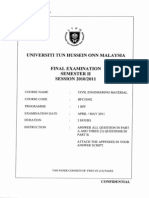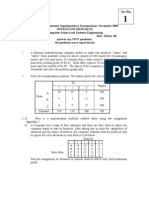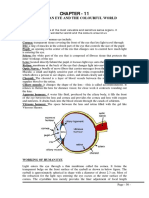Programm - Test Paper - Matrices
Uploaded by
Jagpreet SinghProgramm - Test Paper - Matrices
Uploaded by
Jagpreet SinghQ1- A firm produces three products A, B and C requiring the mix of three materials P, Q and R.
The
requirement (per unit) of each product for each material is as follows.
P Q R
A 2 3 1
M=
B
C
[ ]
4 2 5
2 4 2
Using matrix notations, find
(i). The total requirement of each material if the firm produces 100 units of each product.
(ii). The per unit cost of production of each product if the per unit cost of materials P, Q and R is
Rs 5, Rs 10 and Rs 5 respectively.
(iii). The total cost of production if the firm produces 200 units of each product.
Q2 - Mr. X went to a market to purchase 3 kg of sugar, 10 kg of wheat and 1 kg of salt. In a shop
near to Mr. X’s residence, these commodities are priced at Rs 20, Rs 10 and Rs 8 per kg whereas
in the local market these commodities are priced at Rs 15, Rs 8 and Rs 6 per kg respectively. If
the cost of traveling to local market is Rs 25, find the net savings of Mr. X, using matrix
multiplication method.
Q3 – An automobile company uses three types of steel s 1, s2 and s3 for producing three types of cars c 1,
c2 and c3. The steel requirement (in tons) for each type of car is given below:
Cars
c1 c2 c3
s1 2 3 4
Steel s2 1 1 2
s3 3 2 1
Determine the number of cars of each type which can be produced using 29, 13 and 16 tons of steel of
the three types respectively, using matrix inverse method.
Q4 – A company produces three products everyday. Their total production on a certain day is 45 tons. It
is found that the production of the third product exceeds the production of the first product by 8 tons
while the total combined production of the first and third product is twice that of the second product.
Determine the production level of each product using Cramer’s rule.
You might also like
- Quantitative Techniques - Assignment 1 QuestionsNo ratings yetQuantitative Techniques - Assignment 1 Questions6 pages
- 5 Transportation, Transshipment, Assignment Problems: MSM 2020 Joydip MitraNo ratings yet5 Transportation, Transshipment, Assignment Problems: MSM 2020 Joydip Mitra3 pages
- Unity University Operations Research TBHNo ratings yetUnity University Operations Research TBH4 pages
- Central University of Kerala: "Linear Programming"No ratings yetCentral University of Kerala: "Linear Programming"19 pages
- Application of Matrices in Business and Economics: Holiday Homework 2021-22No ratings yetApplication of Matrices in Business and Economics: Holiday Homework 2021-2237 pages
- ABBS IISEMQP QuantiativetechniquesandoperationsresearchNo ratings yetABBS IISEMQP Quantiativetechniquesandoperationsresearch3 pages
- mineral industries-previous year questionsNo ratings yetmineral industries-previous year questions7 pages
- OPERATION RESEARCH & MANAGEMENT - Model QPNo ratings yetOPERATION RESEARCH & MANAGEMENT - Model QP4 pages
- BEC 2304 Operations Research 1 Year III Semester I-1No ratings yetBEC 2304 Operations Research 1 Year III Semester I-14 pages
- DR Biniam B Quantitative Analysis Assignment0% (1)DR Biniam B Quantitative Analysis Assignment5 pages
- Electrical Engg Subject: Electrical and Electronics Engineering MaterialsNo ratings yetElectrical Engg Subject: Electrical and Electronics Engineering Materials20 pages
- Instructions:-Question ONE Is Compulsory Attempt Any Other TWO Questions. - Marks For Each Question Are Allocated at The End of EachNo ratings yetInstructions:-Question ONE Is Compulsory Attempt Any Other TWO Questions. - Marks For Each Question Are Allocated at The End of Each3 pages
- Sustainable Steel Buildings: A Practical Guide for Structures and EnvelopesFrom EverandSustainable Steel Buildings: A Practical Guide for Structures and EnvelopesBernhard HaukeNo ratings yet
- Durability Design of Concrete Structures: Phenomena, Modeling, and PracticeFrom EverandDurability Design of Concrete Structures: Phenomena, Modeling, and PracticeNo ratings yet
- Ceramics Science and Technology, Volume 4: ApplicationsFrom EverandCeramics Science and Technology, Volume 4: ApplicationsRalf RiedelNo ratings yet
- The Human Eye and The Colourful World: Chapter - 11No ratings yetThe Human Eye and The Colourful World: Chapter - 1123 pages
- Cannot See The Nearby Objects.: Material Downloaded From - 1 / 5No ratings yetCannot See The Nearby Objects.: Material Downloaded From - 1 / 55 pages
- Ch.2: Polynomials: SHIKSHA MANTRA:-198, PKT-1, GANGOTRI APT., SEC-12. PH# 9810232510, 01145588399No ratings yetCh.2: Polynomials: SHIKSHA MANTRA:-198, PKT-1, GANGOTRI APT., SEC-12. PH# 9810232510, 011455883992 pages
- CBSE Class IX Social Science NCERT Solution Chapter 3 Geography Drainage Question 1. Choose The Right Answer From The Four Alternatives Given Below100% (2)CBSE Class IX Social Science NCERT Solution Chapter 3 Geography Drainage Question 1. Choose The Right Answer From The Four Alternatives Given Below7 pages
- Class Ix Physics Numerical Chapter Motion Linear and Circular With Answer100% (2)Class Ix Physics Numerical Chapter Motion Linear and Circular With Answer3 pages
- CH-5: Motion: SHIKSHA MANTRA:-198, GANGOTRI APT. PKT-1, SEC-12 PH # 9810232510, 01124488399No ratings yetCH-5: Motion: SHIKSHA MANTRA:-198, GANGOTRI APT. PKT-1, SEC-12 PH # 9810232510, 011244883996 pages
- CA Found Test Paper - Correlation and RegressionNo ratings yetCA Found Test Paper - Correlation and Regression6 pages
- 9th - Solved - Science - Sa-2 - Sample - Paper - HALF SYLLABUS PDFNo ratings yet9th - Solved - Science - Sa-2 - Sample - Paper - HALF SYLLABUS PDF4 pages
- Test Paper Class 10 - Light and Life Processes100% (1)Test Paper Class 10 - Light and Life Processes2 pages
- Class 9 Test Paper Tissue and Atoms and Molecules100% (1)Class 9 Test Paper Tissue and Atoms and Molecules1 page
- Test Paper Circle and Application of TrigoNo ratings yetTest Paper Circle and Application of Trigo1 page
- Paper 4: Business Mathematics, Logical Reasoning and Statistics Key Part A: Business MathematicsNo ratings yetPaper 4: Business Mathematics, Logical Reasoning and Statistics Key Part A: Business Mathematics1 page
- CA Found Test Paper - Correlation and RegressionNo ratings yetCA Found Test Paper - Correlation and Regression6 pages
- Bloomberg Businessweek Europe March 20-March 26 2017No ratings yetBloomberg Businessweek Europe March 20-March 26 201772 pages
- Financial Strategy Tutorial 1 Questions 2024-4No ratings yetFinancial Strategy Tutorial 1 Questions 2024-44 pages
- AMX4 Collimator Interface Inspection Technical ManualNo ratings yetAMX4 Collimator Interface Inspection Technical Manual9 pages
- International Trade Theories: T.J. JosephNo ratings yetInternational Trade Theories: T.J. Joseph78 pages
- Pre-Market: Stock Trading Before The Markets Open From0% (1)Pre-Market: Stock Trading Before The Markets Open From2 pages
- Commerce Lab Lab Record - Index: S. No. Topic Name (Questions) No. Unit - INo ratings yetCommerce Lab Lab Record - Index: S. No. Topic Name (Questions) No. Unit - I6 pages
- Direction: Write Below All The Words You See.: Word Find Puzzle (20 Points)No ratings yetDirection: Write Below All The Words You See.: Word Find Puzzle (20 Points)2 pages
- 11th-Economics-Public-Exam-March-2024-Official-Answer-Key-English-Medium-PDF-DownloadNo ratings yet11th-Economics-Public-Exam-March-2024-Official-Answer-Key-English-Medium-PDF-Download8 pages
- +2 Eco-Reduced Syllabus - Study Meterial-2021 - 1100% (2)+2 Eco-Reduced Syllabus - Study Meterial-2021 - 116 pages
- Instructor: Ahsan Shah Course: International Business Name:M.Umer RaziNo ratings yetInstructor: Ahsan Shah Course: International Business Name:M.Umer Razi5 pages




















































































































